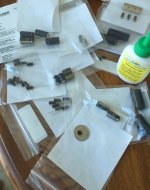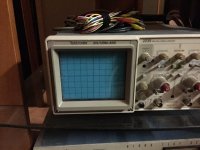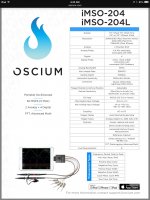I enjoyed listening to the SP10 in the test plinth this weekend. Speed has been good, but the strobe has suddenly stop working. Can anyone point me in the direction to see how to change to LED?
Not sure if anybody has done it... look around.
Anyway, you may get it back once you re-cap the PSU and table, you may have something in the circuit that isn't working properly as opposed to a bad neon.
You need a good 140V. If the neon has blown you can use one from what we know here as a "cooker switch" it may be small but it will work.
Or take the 140V off the strobe transistors, feed 5V and drive a LED(s) from that.
Dave
Or take the 140V off the strobe transistors, feed 5V and drive a LED(s) from that.
Dave
Not sure if anybody has done it... look around.
Anyway, you may get it back once you re-cap the PSU and table, you may have something in the circuit that isn't working properly as opposed to a bad neon.
You need a good 140V. If the neon has blown you can use one from what we know here as a "cooker switch" it may be small but it will work.
Or take the 140V off the strobe transistors, feed 5V and drive a LED(s) from that.
Dave
Thanks guys for the reply!
As I plan more I would like to just remove the strobe. But does this control speed?
6L6, I assume your motor is still out of the body? Could you give me the distance from the tip of the spindle to the bottom of the bearing cap? I need to know about what length of threaded brass to buy for the drain in my plinth.
I'm not sure why outboarding the electronics would do anything for you. Please explain.
I use a Kendo Audio Note Io cartridge which has a very very low output & low compliance. However I was using a variety of low compliance MC cartridges on this TT some 12 years plus ago. When the electronics were taken off the TT assembly and moved outboard the subjective improvement to all aspects of sound quality was very much higher than another identical unit. The whole music was perceived as coming out of a new darkness and presented in improved sound field, wider,deeper and higher with all components more accurately placed - in terms of overall presentation the change was a very great improvement. [I can supply no noise comparison figures as I have very little test equipment]. At that time I lived in London and had several knowledgable friends who were familiar with my system which was basically Be Yamamura electronics, cables and speakers. Even the most cynical agreed that the change was very worth while.
The judgements were all - as I have said - subjective; as such they may not be acceptable to many here!
My instinct is that the removal of such large circuits into a decent closed chassis lessened the effect of magnetic and rf level noise on the cartridge. I agree with those who would say that measurement is necessary so can only offer the hearing experience. In the interest of complete disclosure I would add that the main arm was an FR64s and that the plinth was the solid mineral makers plinth system without the feet. It rested on large blocks of fine grain solid graphite. Also I use an ART (Italy) solid graphite platter-mat of about 7.5mm depth.
The above is my experience of this table as modified. It certainly is the best I have owned and those have included all of the standard classics, the only one which has satisfied me is a well re-worked Lenco with solid carbon (1") mat. I am now rebuilding one for myself…it is a far less expensive route to highest quality TT ownership than is the Thorens 124/Garrard 301 route.🙂
I just turned down an offer of a lenco cheap. That will have to wait until I have room for 3 turntables. But this thread has made me want to scratch the direct drive itch, so the kenwood KD-550 is coming out of storage. Not in the same league as the SP10 but sure I can get good sounds from it.
Thanks for providing the suggestion and link. I have committed to the 312s, my friend has an extra one.Coasttocoast,
Here is a tonearm from Analog Instruments you may be interested in. The wood Siggwan for NZ 1480.00 in development is a metal tonearm for estimated US $1700.00 analogInstruments - Home
The story of the man behind the tonearm.
Next build. - AudioEnz
I put some snubbers in my F5T, and the Temp went down. Form 50 deg C to 45. So what's up.... did the snubbers redunce ringing?
I think so, at a purely anecdotal level./
It is true though, that at the same settings on P1 P2, I get 5 deg cooler hearsinks with snubbing.....
YMMV
I think so, at a purely anecdotal level./
It is true though, that at the same settings on P1 P2, I get 5 deg cooler hearsinks with snubbing.....
YMMV
Last edited:
Thanks for the confirmation on the possible value in out boarding the electronics. As to the subjective part, I haven't found anyone yet who has been able to post verifiable test reports.I use a Kendo Audio Note Io cartridge which has a very very low output & low compliance. However I was using a variety of low compliance MC cartridges on this TT some 12 years plus ago. When the electronics were taken off the TT assembly and moved outboard the subjective improvement to all aspects of sound quality was very much higher than another identical unit. The whole music was perceived as coming out of a new darkness and presented in improved sound field, wider,deeper and higher with all components more accurately placed - in terms of overall presentation the change was a very great improvement. [I can supply no noise comparison figures as I have very little test equipment]. At that time I lived in London and had several knowledgable friends who were familiar with my system which was basically Be Yamamura electronics, cables and speakers. Even the most cynical agreed that the change was very worth while.
The judgements were all - as I have said - subjective; as such they may not be acceptable to many here!
My instinct is that the removal of such large circuits into a decent closed chassis lessened the effect of magnetic and rf level noise on the cartridge. I agree with those who would say that measurement is necessary so can only offer the hearing experience. In the interest of complete disclosure I would add that the main arm was an FR64s and that the plinth was the solid mineral makers plinth system without the feet. It rested on large blocks of fine grain solid graphite. Also I use an ART (Italy) solid graphite platter-mat of about 7.5mm depth.
The above is my experience of this table as modified. It certainly is the best I have owned and those have included all of the standard classics, the only one which has satisfied me is a well re-worked Lenco with solid carbon (1") mat. I am now rebuilding one for myself…it is a far less expensive route to highest quality TT ownership than is the Thorens 124/Garrard 301 route.🙂
But with the existing knowledge that almost everything effects the low output signal from the needle and that Technics out boarded the electronic in the SP-10MKIII, it's not too much of a leap of faith that out boarding the electronics in the MKII would provide a benefit.
For my build, the possible benefit from moving the electronics is just icing on the cake. I think there could also be a bigger sonic benefit from eliminating as much free area (voids) in the plinth as possible. I want as much mass as possible in the smallest footprint. Moving the electronics, strobe, switches, etc off the plinth and only machine out for the motor, bearing drain, and arm/arm board should make for a good experiment.
With the 100% Panzerholz (I decided to hold off on adding any aluminum for now) (not counting the brass/iron bearing drain) the plinth should be pretty dense, with me painting the plinth in high gloss black I hope to bring back some life. Don't know for sure, but again, good experiment.
There was a delay in the Panzerholz getting cut into pieces for easier shipping (sick carpenter), now set to leave London Monday. The caps, oil and bearing cap have arrived so phase one of the rebuild can start. Doing some beach and tourist stuff with relatives in town this weekend, so maybe next week.
I haven't pulled the bearing cover off yet, so I had no concept of the size of the thrust pad. This thing is tiny. It's the little piece on top of the quarter in the pic

I haven't pulled the bearing cover off yet, so I had no concept of the size of the thrust pad. This thing is tiny. It's the little piece on top of the quarter in the pic

OK, I am experienced, qualified and wrote 4 pages about Direct Drive turntables recently in the national press.
Unlike some classic turntables, there is absolutely no interference from the SP-10 electronics into the most sensitive cartridge.
The motor harness carries a three phase 50Khz AM signal, a 50Khz excitation supply, a very low signal from the tacho and a three phase 30V up to 1A motor current. Mix these all up together and you are in big trouble. OK the SP-10 MKIII does just that, but the cable used is both appropriate and screened in the critical areas.
What will also be an issue, is that all this 50Khz and big motor currents will now spray fields from the new external cable into all the other equipment nearby, unless it is properly screened.
I might well do exactly the same thing soon, but I will select the right cable and measure everything carefully, including the end result of all aspects of actual speed stability. This isn't for the faint hearted and the end result if not carried out properly, could result in wow-flutter being several times greater and load stability adversely affected and subtle changes in all the nearby equipment.
Regards
Dave
Unlike some classic turntables, there is absolutely no interference from the SP-10 electronics into the most sensitive cartridge.
The motor harness carries a three phase 50Khz AM signal, a 50Khz excitation supply, a very low signal from the tacho and a three phase 30V up to 1A motor current. Mix these all up together and you are in big trouble. OK the SP-10 MKIII does just that, but the cable used is both appropriate and screened in the critical areas.
What will also be an issue, is that all this 50Khz and big motor currents will now spray fields from the new external cable into all the other equipment nearby, unless it is properly screened.
I might well do exactly the same thing soon, but I will select the right cable and measure everything carefully, including the end result of all aspects of actual speed stability. This isn't for the faint hearted and the end result if not carried out properly, could result in wow-flutter being several times greater and load stability adversely affected and subtle changes in all the nearby equipment.
Regards
Dave
A few people have asked about the Direct Drive article, it can be found here :
http://www.soundhifi.com/FOURUMIMAGES/DC.pdf
http://www.soundhifi.com/FOURUMIMAGES/DC.pdf
Since the motor is the closest to the cartridge, is its shell sufficient enough along with the shielded cable to not require any modifications in itself?
Thanx for the article
Regards
David
Thanx for the article
Regards
David
I think this already answered that ? (below)Since the motor is the closest to the cartridge, is its shell sufficient enough along with the shielded cable to not require any modifications in itself?
Unlike some classic turntables, there is absolutely no interference from the SP-10 electronics into the most sensitive cartridge.
However
along with the shielded cable
This isn't "just" a shielded cable, individual groups of cores need their own screening and the motor can take an amp or a bit less. David, if you can do some research on shielded cable and report back, it would help us all in the ultimate quest ?
Thanks
Dave
Last edited:
Hey guys, I recently got myself a present and bought a SP-10mkii. I was wondering if the psu discussed here would be much better to the one it has: SH-10E?
Another thing, Jim, what do you think are benefits of using 10" jelco vs 9" one?
Another thing, Jim, what do you think are benefits of using 10" jelco vs 9" one?
Fantastic! Welcome to the adventure. 🙂
PSU - just do a recap of the stock supply and see if everything works well. If so, don't worry about something different - I bought 2 decks with no PSU, hence why needing to build my own. If they came with stock PSU, that's what I'd use.
The deck really is made for a 10" arm so in all reality the longer Jelco is perfect. If, at the end of this adventure, I have 2 working decks, I've always planned on getting the Jelco 750E.
PSU - just do a recap of the stock supply and see if everything works well. If so, don't worry about something different - I bought 2 decks with no PSU, hence why needing to build my own. If they came with stock PSU, that's what I'd use.
The deck really is made for a 10" arm so in all reality the longer Jelco is perfect. If, at the end of this adventure, I have 2 working decks, I've always planned on getting the Jelco 750E.
What do you guys think about applying some vibration dampening paints/pastes underneath the metal chassis?
Something like this:
Silent Running - high performance sound and vibration dampening coating for marine vessels
or this:
Spectrum - 1 Gallon - Second Skin Audio
Liquid Sound Deadener Manufacture Product Line SPrayDead
Something like this:
Silent Running - high performance sound and vibration dampening coating for marine vessels
or this:
Spectrum - 1 Gallon - Second Skin Audio
Liquid Sound Deadener Manufacture Product Line SPrayDead
I've thought about it, and figured that if I did, it would only be in small amounts. If the chassis needed to be dead, that would have made it that way...
Well, chemistry improved a lot since 80th. They did not put these sort of compounds underneath metal kitchen sinks back in the days.
I can't understand how it can be harmful? It only affects "secondary" vibrations -- ringing. You will still have a metal chassis first. When I used dynamat on my thorens 160, improvement was so huge!
I will definitely try, but can't chose one 🙂. I am thinking of trying it on sl1200 first 🙂
I can't understand how it can be harmful? It only affects "secondary" vibrations -- ringing. You will still have a metal chassis first. When I used dynamat on my thorens 160, improvement was so huge!
I will definitely try, but can't chose one 🙂. I am thinking of trying it on sl1200 first 🙂
- Home
- Source & Line
- Analogue Source
- The Incredible Technics SP-10 Thread

